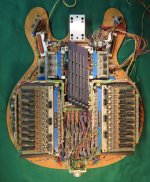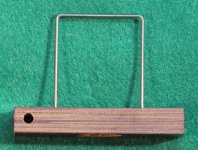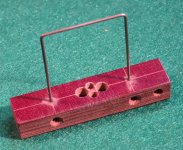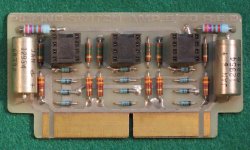Good looking. Might work. Won't do pitch bend.
For more various sounds, would work better going to a midi encoder than a shober theater organ. http://www.dtsmidisystems.com/midiencoders.html
Please sell me the shober theatre organ electronics to repair my shober recital organ.
For more various sounds, would work better going to a midi encoder than a shober theater organ. http://www.dtsmidisystems.com/midiencoders.html
Please sell me the shober theatre organ electronics to repair my shober recital organ.
Today MIDI is an easy choice. It was not a choice at all in the 1970's as the standard did not exist until 1983. There were several proprietary computer to keyboard or sound creation device in the 70's. The PC we know today did not even exist until 1981. Before that it was the TRS-80, Apple II or the Comodore PET and it's offspring. The only one of the bunch that was DIY cloneable was the Apple II.
I liked, but could not even dream of buying, the Soundchaser system from Passport Designs, a plug in card for the Apple II computer that made some decent synthesized sounds. It appeared in the early 80's then vanished when Roland and several other big name keyboard / synthesizer companies got together to create the MIDI interconnection standard. The Roland MPU-401 PC to MIDI interface wasn't readily available until the mid 80's.
I liked, but could not even dream of buying, the Soundchaser system from Passport Designs, a plug in card for the Apple II computer that made some decent synthesized sounds. It appeared in the early 80's then vanished when Roland and several other big name keyboard / synthesizer companies got together to create the MIDI interconnection standard. The Roland MPU-401 PC to MIDI interface wasn't readily available until the mid 80's.
Nice looking neck and details! I like the "string" inlays going up to the machine head "posts". The somewhat corny caps on the tuners are adorable as well. Looks like a substantial effort was made. Are the transistor switches 'reliable' in being associated with those contacts? There's a difference between works and works reliably. Just wondering if that has to do with the % RH in the room, how nervous the player is, etc.
I guess I'd have to see the other half to comment further, that which initiates the sound. You mentioned virtual capo with LED markers, that implies open strings sounding, so there must be something that the right hand does to 'pluck the open string.
I guess I'd have to see the other half to comment further, that which initiates the sound. You mentioned virtual capo with LED markers, that implies open strings sounding, so there must be something that the right hand does to 'pluck the open string.
Hello all,
The photos I had scanned, didn't turn out to well and I had to re-photograph them, hence the lack of posts.
I finally found all my file folders documenting my guitar. I am redrawing the picking switches in my CAD program and I should have some nice graphics ready to post in a day or two.
Hi indianajo, I am not ignoring you. I am working on a reply.
Sincerely,
Ralf
The photos I had scanned, didn't turn out to well and I had to re-photograph them, hence the lack of posts.
I finally found all my file folders documenting my guitar. I am redrawing the picking switches in my CAD program and I should have some nice graphics ready to post in a day or two.
Hi indianajo, I am not ignoring you. I am working on a reply.
Sincerely,
Ralf
I think it maybe better to replace transistors with MOSFETs (e.g. MMBF170), as they're easier to turn-on, even in presence of the said variables. Being a charge-driven device, a MOSFET also appears to be more suitable for the job when compared to current-driven transistor.Are the transistor switches 'reliable' in being associated with those contacts? There's a difference between works and works reliably. Just wondering if that has to do with the % RH in the room, how nervous the player is, etc.
I had some vague memories of something outrageous that I saw maybe 10 years ago. I kept throwing random guesses at the YouTube algorithm trying to get lucky without much success. After watching several pretty lousy videos about "laser guitars" and seeing all of the Guthman musical instrument competition videos from Georgia Tech, I gave up. Note that most of the Guthman stuff is worth watching though.
Today, out of nowhere, there it was.....The Misa Digital guitar from 13 years ago. The stringless neck is much like the one in the OP's pictures and a lifeless touch screen is sitting where the pickups go. The whole thing springs to life in the hands of an expert player.
It also seems that during the 13 years since that video posted the original instrument in the video had evolved into the Kitara and the Tri-Bass, and six months ago Misa introduced the Triwave.
So now the stringless guitar has evolved into a guitar shaped MIDI controller whose sound is created inside the computer.
Today, out of nowhere, there it was.....The Misa Digital guitar from 13 years ago. The stringless neck is much like the one in the OP's pictures and a lifeless touch screen is sitting where the pickups go. The whole thing springs to life in the hands of an expert player.
It also seems that during the 13 years since that video posted the original instrument in the video had evolved into the Kitara and the Tri-Bass, and six months ago Misa introduced the Triwave.
So now the stringless guitar has evolved into a guitar shaped MIDI controller whose sound is created inside the computer.
Couldnt help but notice they're sold out already. To me, the touch pad makes sense as an existing way to transform strumming hand gestures into triggers and modifying control parameters. Now, if such a pad was designed to accommodate strike velocity too, well, that would be something. Unsure if it's a custom pad or just x-y but no "z".and six months ago Misa introduced the Triwave.
Looks like it could be a fun little toy, especially in the hands of an older person like myself, who's fingers arent getting better with time; at first this one wont close; I challenged a suggested operation, now it closes again, but now the index one doesnt want to close. Unsure if that's going to go away too, or what? A three string fretboard may work better with the remaining fingers...
A quick search failed to come up with a price in the Triwave, but it's safe to assume that they are well out of my price range. I did see some talk about Kitaras going from anywhere between $900 and $3000 depending on who, where, and what condition.
The cheapest and most effective way to build a guitar based controller would be to reverse engineer a cheap midi control keyboard. You'd have to group the overlapping notes (same note on different fret / string positions) via diode matrix and use break before make contacts to simulate velocity. The problem you'd have is interpreting events like hammer-ons, muted (ghosted) notes and bends. If you're ok without those, you'll be well served with re-purposing a keyboard midi controller. I dont see getting close to simulating the feel of a real guitar using any other human interface component than actual guitar strings.
IMHO a string-less guitar is an oxymoron because the play interface of a guitar is strings, by definition. Stringless pianos (aka electronic keyboards/synthesizers), on the other hand, are real.
Key-less synthesizers would be more appropriate term, in this case with a play interface which in some aspects resembles that of a guitar.
We already have regular keyboards with an extension "neck" for additional play control (mod wheel and pitch-bender etc). To make that more guitar'ish, I'd reduce the number of regular keybed keys with velocity and aftertouch sensing to 6 (or whatever the string count) and extend the neck part to sense "fretting" positions (which create pitch modulation for the original keys) and some more info like fingering-force for hammer-ons and damping, some extent of exact fingering position, stuff like that.
I'd probably also add sensors that detect push/pull forces on the neck for further sources of possible modulation.
In the end, a keyboard with reduced number of more or less "traditional" keys but with much more enhanced expression/modulation features offered for the "free" hand. Could be quite attractive to open-minded keyboard players with some guitar playing background.
As far as I can see, making a proper string-emulating front-end for the main hand (plucking hand) to appeal more to guitar players, while not outright impossible, would be much more complex.
Key-less synthesizers would be more appropriate term, in this case with a play interface which in some aspects resembles that of a guitar.
We already have regular keyboards with an extension "neck" for additional play control (mod wheel and pitch-bender etc). To make that more guitar'ish, I'd reduce the number of regular keybed keys with velocity and aftertouch sensing to 6 (or whatever the string count) and extend the neck part to sense "fretting" positions (which create pitch modulation for the original keys) and some more info like fingering-force for hammer-ons and damping, some extent of exact fingering position, stuff like that.
I'd probably also add sensors that detect push/pull forces on the neck for further sources of possible modulation.
In the end, a keyboard with reduced number of more or less "traditional" keys but with much more enhanced expression/modulation features offered for the "free" hand. Could be quite attractive to open-minded keyboard players with some guitar playing background.
As far as I can see, making a proper string-emulating front-end for the main hand (plucking hand) to appeal more to guitar players, while not outright impossible, would be much more complex.
At least in some. Perhaps I've been just playing too much, but the left index is complaining. I imagine a day will come when all I can do is pull along the length of a ribbon and hit something to trigger an envelope with the other hand. Maybe a footswitch to lengthen the sustain, a pedal to center the RLPF frequency. Anyone care to trade-off solos?a play interface which in some aspects
With the Karplus-Strong algorithm and the computational ability we have today, it is no longer necessary to have actual strings to get the sound of a string instrument, especially a plucked string type like the guitar.IMHO a string-less guitar is an oxymoron ....
In simple terms, a vibrating string is analogous to a transmission line.
Hi all,
In this post I will introduce the body of the instrument and its contents, particularly the picking switches.
The picking switches basically consist of a wire form resembling an over-sized paper clip. The material is music wire and its diameter is .045" which represents the average diameter of the six strings found on an acoustic guitar, strung with medium gage strings. The two legs of the wire form are fastened to a base made of Delrin. Also mounted on the base is a Delrin coil housing with a coil of magnet wire. Inside the coil is a soft steel pole piece with a chisel shaped face and behind that is an Alnico magnet.
After I built a single picking switch prototype, I tested it with an oscilloscope and then I designed a "string" of four picking switches mounted on a single Delrin base. The whole device basically functioned like an ordinary electric guitar pick-up.
I then placed six picking switch assemblies next to each other, supported by Delrin brackets to form the complete picking switch assembly. The end result is that, I now have an assembly of twenty-four picking switches. Each picking switch is connected to its own amplifier on a printed circuit board.
Most of the mechanical parts of the instrument exist as sketches. The are accurate but they are sketches nevertheless. So, I spent the last several days, recreating some of them in my world-class CAD program which I didn't own 47 years ago, in order to make it easier to understand the functioning of my instrument.
The first image shown is the body of the instrument with all its contents.
The second image shown is the prototype of the picking switch.
The third image shown is an isometric view of the second image.
The fourth image shown is a CAD version of the complete prototype picking switch assembly.
The fifth image shown is a CAD version of a "string bar" of four picking switch assemblies.
The sixth image ditto of the fifth image.
The seventh image shown is the complete picking switch assembly with the finger board at its left side.
The final image shown is one of the picking switch amplifier printed circuit boards.
Sincerely,
Ralf.
In this post I will introduce the body of the instrument and its contents, particularly the picking switches.
The picking switches basically consist of a wire form resembling an over-sized paper clip. The material is music wire and its diameter is .045" which represents the average diameter of the six strings found on an acoustic guitar, strung with medium gage strings. The two legs of the wire form are fastened to a base made of Delrin. Also mounted on the base is a Delrin coil housing with a coil of magnet wire. Inside the coil is a soft steel pole piece with a chisel shaped face and behind that is an Alnico magnet.
After I built a single picking switch prototype, I tested it with an oscilloscope and then I designed a "string" of four picking switches mounted on a single Delrin base. The whole device basically functioned like an ordinary electric guitar pick-up.
I then placed six picking switch assemblies next to each other, supported by Delrin brackets to form the complete picking switch assembly. The end result is that, I now have an assembly of twenty-four picking switches. Each picking switch is connected to its own amplifier on a printed circuit board.
Most of the mechanical parts of the instrument exist as sketches. The are accurate but they are sketches nevertheless. So, I spent the last several days, recreating some of them in my world-class CAD program which I didn't own 47 years ago, in order to make it easier to understand the functioning of my instrument.
The first image shown is the body of the instrument with all its contents.
The second image shown is the prototype of the picking switch.
The third image shown is an isometric view of the second image.
The fourth image shown is a CAD version of the complete prototype picking switch assembly.
The fifth image shown is a CAD version of a "string bar" of four picking switch assemblies.
The sixth image ditto of the fifth image.
The seventh image shown is the complete picking switch assembly with the finger board at its left side.
The final image shown is one of the picking switch amplifier printed circuit boards.
Sincerely,
Ralf.
Attachments
-
 guitar_stringless_body.jpg646.2 KB · Views: 76
guitar_stringless_body.jpg646.2 KB · Views: 76 -
 picking_switch_test.jpg667.4 KB · Views: 72
picking_switch_test.jpg667.4 KB · Views: 72 -
 picking_switch_isometric.jpg578 KB · Views: 70
picking_switch_isometric.jpg578 KB · Views: 70 -
experimental_picking_switch_complete_assy.pdf42.3 KB · Views: 87
-
string_bar_assy_1of1.pdf33.3 KB · Views: 77
-
string_bar_assy_1of2.pdf40.2 KB · Views: 85
-
Picking switches, 24-pack.pdf77.3 KB · Views: 78
-
 picking_switch_amplifier.jpg406.7 KB · Views: 65
picking_switch_amplifier.jpg406.7 KB · Views: 65
Last edited:
- Home
- Live Sound
- Instruments and Amps
- My failed attempt to design and build a stringless electronic guitar